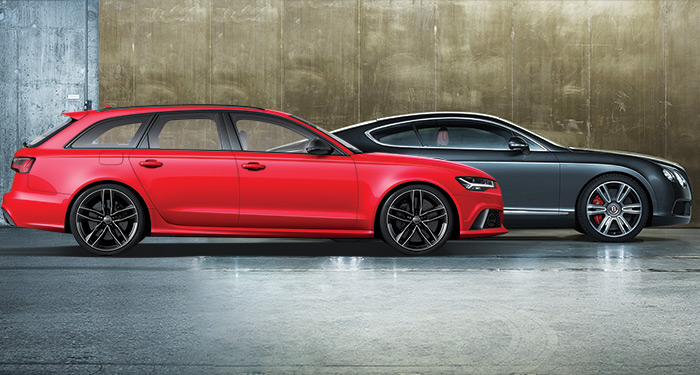
Having a look through the power and torque figures of the Volkswagen Group makes for some very interesting reading. There’s no doubt that it leads the way in producing technologically advanced engines, with enviable power figures – you only have to look at some of the latest diesels, concept engines, and, of course, the Bugatti Veyron to discover that. But there’s an internal struggle that appears on paper, and it’s hard to know who’s pulling the strings. There’s a literal power play, with some brands allowed to feature certain power figures and others, with the same engine, quite a lot less.
Last week I had the latest Bentley Continental GTC V8S. It truly is a beautiful machine, with fabulous sound, beautiful ride, superb quality, and enough room to throw the kids in the back with picnic gear in the boot. But it uses the same engine as the Audi RS6, so you have to wonder why Audi equips its wagon with 552bhp and lets Bentley languish with 521bhp. Being higher up in the food-chain, the Bentley, you would think, would have more grunt. Of course, it would never be as quick, as it’s so much heavier, but giving it the power boost required would certainly help its cause. After all, that much extra horsepower isn’t going to come at the expense of reliability – the Audi does it with no issues. Likewise the Golf R. In Mk VII form it’s a fabulous steer (far better than the understeering abomination which was the Mk VI), and it’s practical too. Look through the Audi S3’s power figures (which uses the same engine), and something becomes obvious. In certain countries, Volkswagen hasn’t been allowed to release the Golf R with the same power as the S3. The stated reason is that engines have been detuned to suit “hot weather climate” conditions.
Yet the Audi can carry on with more horsepower, albeit only a handful more. So, who’s really pulling the strings here? Lamborghini is allowed to get away with a lot more grunt from its 5.2 litre V10 than Audi is from its R8 V10. So, is there some sort of pecking order that’s unwritten? It’s not just the VW, though. Both MINI and BMW use the same 1.6 litre turbo engine, but BMW only offers a max of 166bhp from its four-banger, while MINI can bump it up to 180bhp. Wouldn’t the 1 Series hatch be a whole lot more appealing with that extra 14bhp available? Sure, you can always take it to a tuner who can piggy-back the ECU or write a whole new tune on it. But when we pay good money to manufacturers to give us their best, it kind of feels like we’re being short-changed. GM and its LSX series is a classic example of this.
A tuned exhaust manifold, remap, cold-air intake and suddenly it’s up by 80hp or more. And it’s often using less fuel when it does it. Are we living in an age of lazy engineering? Or are we living through an era of a (literal) power play, where certain brands are allowed to call the shots? Either way, it’s the tuners who’ll be rubbing their hands with glee. Power upgrades are comparatively cheap, and unless you go ballistic with power levels, they’re reliable, too. It’s one of the reasons that tuners like ABT are doing so well. I dare you not to look through an ABT catalogue, for instance, and start mentally spending money on enhancements. “One supercharger kit for an R8, please...”























Write your Comment